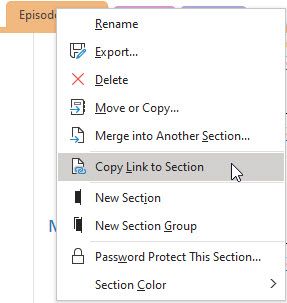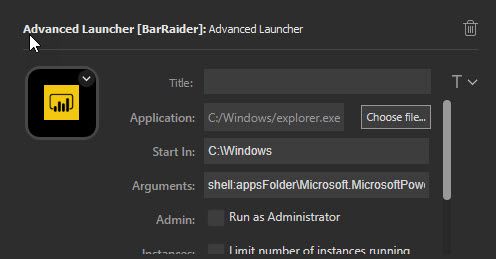Just a couple of quick tips for using the Advanced Launcher plugin I discussed earlier:
Microsoft Teams
The default Teams shortcut in the Windows menu calls C:\Users<username>AppData\Local\Microsoft\Teams\Update.exe. If you want the running indicator, set the Application to C:\Users<username>\AppData\Local\Microsoft\Teams\current\Teams.exe since that is the actually exe that is running.
OneNote Sections
Sections in a OneNote notebook are address-able, and can be added to the command line. (I use OneNote for Microsoft 365. No guarantees for the Windows 10 version.) For notebooks stored in OneDrive, finding the correct argument can be a bit difficult. These steps, summarized from Stack, should work:
- In OneNote, right-click on the section tab and select "Copy Link to Section".

- Paste the link in Notepad. It is quite lengthy.
- There will be two URIs (links), separated by a space or a carriage return. The first is an
httpsURI to OneNote. (Might be a page in your SharePoint tenant if the notebook is in a Team or OneDrive for Business.) The second URI will have theonenote:scheme. This is the URI you want. (It is URL encoded and ends with&end. Leave it as is, copy all of it.) - In the Advanced Launcher, specify the arguments as
/hyperlink [onenote: uri from above]
Windows "Store" apps
If you want to launch a Windows "Store" Application, you need to launch it from Windows Explorer. The steps below are summarized from Tobias Möritz (@tobimori) with additional info from the Microsoft Answers site:
- Using PowerShell, get the details of the Appx package:
Get-AppxPackage | ?{$_.name -like '*powerbi*'} | fl InstallLocation, PackageFamilyName
- Navigate to the directory listed as the
InstallLocation- Open the
AppxManifest.xmlfile- Locate the
<Application>element for the application you wish to run- Make note of the
Idattribute- In the Stream Deck, Advanced Launcher action, set the Application to
C:\Windows\explorer.exe- Use the PackageFamilyName and application Id in the arguments:
shell:appsFolder\<PackageFamilyName>!<Id>
For Windows Store apps, the instance limit and running indicator will not be helpful, since the action thinks the application is Windows Explorer (explorer.exe) which is always running.
